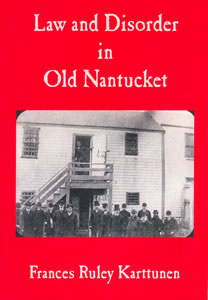
Nantucket: Places and People| Nantucket's North Shore|
Moses Tapped The Washing Pond| Ways Off Shore|
Nantucket’s North Shore: A Neighborhood History| Something Should Be Done
Bawdy houses, knife fights, marauding gangs of miscreants, and
buckets and buckets of rum, all cheek by jowl with plain and sober
Quakers.
The author describes this as a beach book for the
historically minded.
Neighborhoods, Colorful Characters, and Hangings.
Well, thanks to Frances Ruley Karttunen, they can. Nantucket’s nuanced history is given fresh perspective and clear voice in two new works by the linguist, historian, and author. Nantucket Places & People, volumes 1 and 2, are delightful books that offer discoveries and insights into an island we thought we knew so well.
Recently published, and compiled to commemorate the island’s 350th birthday (which came and went this year), the vignettes included in each volume are like treasures found in an old attic or cellar. History may be all around us, but through these books the island’s past becomes vivid and accessible as Karttunen leads us to specific places where house histories are revealed and the denizens of another age come to life. Consider these two books guides to old Nantucket. Intended to be used on a self-led walking tour, each informative chapter can easily be read as you stand before the landmarks Karttunen describes.
Follow her as she leads in volume one through town and westward up Main Street, while in volume two we journey south of Main Street toward mid-island and the area called Newtown. Included on the back of each volume is a handy map, detailing locations and proximities of the buildings on the tour.
There are the well-known landmarks, of course—the Atheneum, the Pacific Bank, the Pacific Club—and Karttunen mines fresh information about all of them, but there are also the lesser known places that are given new life through her investigations.
We learn, for example, in Main Street to the North Shore, about the stately Sea Cliff Inn—the hotel that gave Cliff Road its name—and the former baseball diamond nearby, a once open pasture that is now overgrown and unrecognizable as the place where Nantucketers enjoyed the national pastime. We discover, too, that Monument Square was the center of town at one time, and that the Academy Hill School was not the first, but the second school built on the site.
In South of Main Street, we discover the science and reasoning behind the town’s meridian markers (approved by town meeting voters “for no more than $75”), the origin of Chicken Hill, the story of Alfonso Hall, about the place called New Guinea, and the vagaries and evolution of the island’s public schools (including a former schoolhouse on Bear Street). Like its companion volume, South of Main Street has its own collection of noteworthy characters, including Elisha Pope Fearing Gardner, the “Peanut Man of Poet’s Corner;” the inimitable educators Cyrus Peirce and Anna Gardner; Eunice Ross, who challenged the island’s school segregation laws in the mid-1800s; Lucretia Coffin Mott; and, of course, Nantucket’s famed astronomer Maria Mitchell.
South of Main Street also highlights Nantucket’s heritage as a melting pot, where people of African, Azorean, Cape Verdean, and Irish descent settled in the “New Town” area of the island. We learn about the differently designed mills on Mill Hill, why one of them was intentionally blown up and how “school was let out for the day so children could join their parents in the crowd that turned out to watch.”
There’s more, of course. All told in an easy conversational style. Who knows what history lurks behind the old shingles and clapboards of town?
Why, Frances Karttunen. And now, so do we.
Another enjoyable book worth revisiting is Karttunen’s Law and Disorder in Old Nantucket, first published in 2007. Hangings, whippings, robberies, and brandings comprised the island’s genial atmosphere in its early days. (Yes, branding. As Karttunen notes, “Habitual criminals found guilty of breaking and entering were sentenced to being branded with the letter ‘B’ on their foreheads. Between 1713 and 1729 seen men were so branded….”) There were even two prison lockups, the surviving Old Gaol off Vestal Street and the Nantucket County and Town House of Correction next door.
There were bordellos, to be sure, some riots, and rum-running too.
And they say it used to be nicer on Nantucket!
Taken as a whole or separately, these inviting little books add flavor to the island’s historic record and prove that the stories behind the stories are sometimes the most fascinating of all. All three are available at the island’s bookstores and can also be found on the shelves of the NHA’s research library and the Atheneum.
Steve Sheppard
Historic Nantucket, Volume 59, No. 3 (Fall 2009)